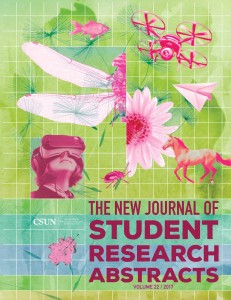
(NORTHRIDGE, Calif., March 12, 2018) — California State University, Northridge biology professor Steven Oppenheimer is celebrating 22 years of collaboration with Los Angeles Unified School District (LAUSD) teachers to promote science, technology, engineering and mathematics (STEM) research done by K-12 students in volume number 22 of “The New Journal of Student Research Abstracts.”
A symposium, scheduled for March 18 at 1:30 p.m. in the Grand Salon of the University Student Union, will feature nearly 200 posters from the participating LAUSD students.
The annual symposium — where CSUN faculty and staff meet students, their parents, and teachers to celebrate the science projects they worked on — is one of Oppenheimer’s favorite parts about the journal program.
“When the kids hear their names for a medal, the place is in an uproar,” Oppenheimer said. “It’s better than any sports game. That, I think, is one of the greatest things to see.”
The journal was first published in 1995 as an offshoot of lectures and workshops that CSUN was holding for science teachers for several years prior. The workshops, now known as the journal program, were designed to empower educators and help them come up with creative research materials and ideas for their classrooms to engage students in academic research.
“It began to be apparent that a student journal would be the perfect way for teachers to take what they were learning and incorporate it into their students’ learning,” Oppenheimer said. “The biggest challenges that teachers face in getting students excited about science is that they are inundated with so much work, forms and tests. It really takes a true pioneer to do extra work in getting the students excited about science.”
This year, the journal won the Oviatt Library Open Access Award presented by library dean Mark Stover. Oppenheimer noted that all 22 volumes of the journal are available online, due to the effort of the library staff.
Oppenheimer said he believes the project will eventually have a global impact.
“Just in the last couple of years, this journal has been on the Web, along with every issue that we have ever published,” Oppenheimer said. “Now, anyone in the world can read it to get ideas for research, and people can also submit abstracts to the journal. So, I envision the journal getting much larger coverage as people around the world begin to read it and contribute.”
The project was recognized at the White House STEM conference and by CSU Chancellor Timothy P. White.